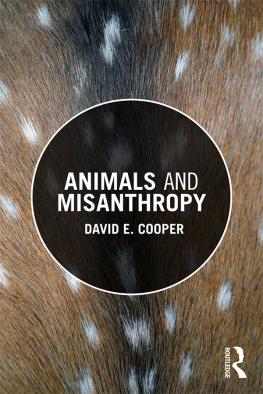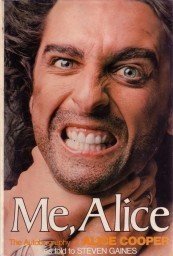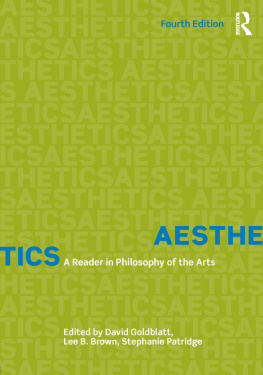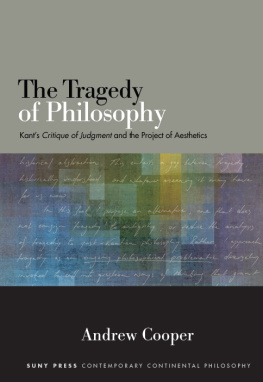David E. Cooper - Aesthetics: The Classic Readings
Here you can read online David E. Cooper - Aesthetics: The Classic Readings full text of the book (entire story) in english for free. Download pdf and epub, get meaning, cover and reviews about this ebook. year: 2019, genre: Religion. Description of the work, (preface) as well as reviews are available. Best literature library LitArk.com created for fans of good reading and offers a wide selection of genres:
Romance novel
Science fiction
Adventure
Detective
Science
History
Home and family
Prose
Art
Politics
Computer
Non-fiction
Religion
Business
Children
Humor
Choose a favorite category and find really read worthwhile books. Enjoy immersion in the world of imagination, feel the emotions of the characters or learn something new for yourself, make an fascinating discovery.

- Book:Aesthetics: The Classic Readings
- Author:
- Genre:
- Year:2019
- Rating:4 / 5
- Favourites:Add to favourites
- Your mark:
- 80
- 1
- 2
- 3
- 4
- 5
Aesthetics: The Classic Readings: summary, description and annotation
We offer to read an annotation, description, summary or preface (depends on what the author of the book "Aesthetics: The Classic Readings" wrote himself). If you haven't found the necessary information about the book — write in the comments, we will try to find it.
Aesthetics: The Classic Readings — read online for free the complete book (whole text) full work
Below is the text of the book, divided by pages. System saving the place of the last page read, allows you to conveniently read the book "Aesthetics: The Classic Readings" online for free, without having to search again every time where you left off. Put a bookmark, and you can go to the page where you finished reading at any time.
Font size:
Interval:
Bookmark:
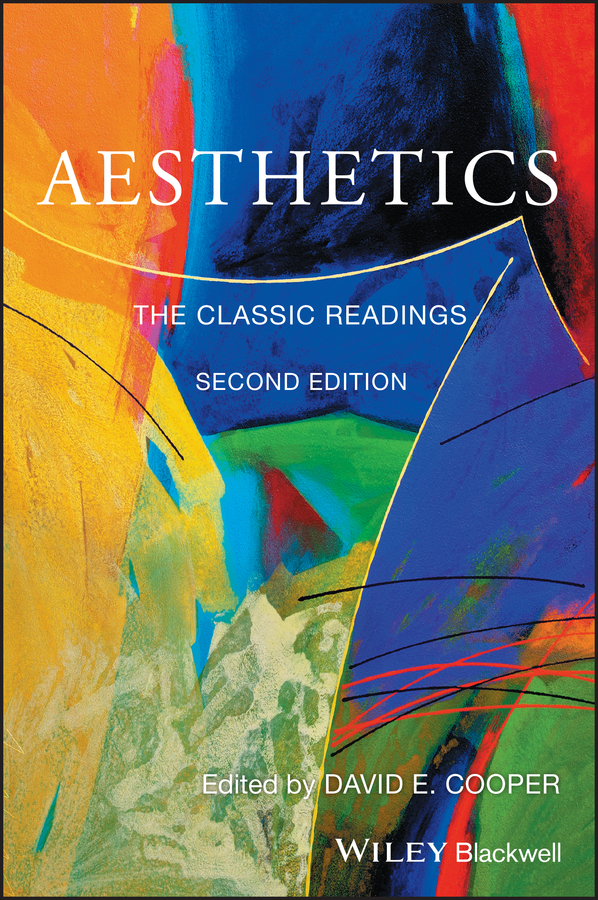
SECOND EDITION
Edited by David E. Cooper

This edition first published 2019
2019 John Wiley & Sons, Inc.
Blackwell Publishing Ltd. (1e, 1997)
All rights reserved. No part of this publication may be reproduced, stored in a retrieval system, or transmitted, in any form or by any means, electronic, mechanical, photocopying, recording or otherwise, except as permitted by law. Advice on how to obtain permission to reuse material from this title is available at http://www.wiley.com/go/permissions.
The right of David E. Cooper to be identified as the author of the editorial material in this work has been asserted in accordance with law.
Registered Office
John Wiley & Sons, Inc., 111 River Street, Hoboken, NJ 07030, USA
Editorial Office
9600 Garsington Road, Oxford, OX4 2DQ, UK
For details of our global editorial offices, customer services, and more information about Wiley products visit us at www.wiley.com.
Wiley also publishes its books in a variety of electronic formats and by printondemand. Some content that appears in standard print versions of this book may not be available in other formats.
Limit of Liability/Disclaimer of Warranty
While the publisher and authors have used their best efforts in preparing this work, they make no representations or warranties with respect to the accuracy or completeness of the contents of this work and specifically disclaim all warranties, including without limitation any implied warranties of merchantability or fitness for a particular purpose. No warranty may be created or extended by sales representatives, written sales materials or promotional statements for this work. The fact that an organization, website, or product is referred to in this work as a citation and/or potential source of further information does not mean that the publisher and authors endorse the information or services the organization, website, or product may provide or recommendations it may make. This work is sold with the understanding that the publisher is not engaged in rendering professional services. The advice and strategies contained herein may not be suitable for your situation. You should consult with a specialist where appropriate. Further, readers should be aware that websites listed in this work may have changed or disappeared between when this work was written and when it is read. Neither the publisher nor authors shall be liable for any loss of profit or any other commercial damages, including but not limited to special, incidental, consequential, or other damages.
Library of Congress CataloginginPublication Data
Names: Cooper, David E. (David Edward), 1942 editor.
Title: Aesthetics : the classic readings / edited by David E. Cooper.
Description: Second Edition. | Hoboken : Wiley, 2019. | Includes bibliographical references and index. |
Identifiers: LCCN 2018052860 (print) | LCCN 2018056147 (ebook) | ISBN 9781119116813 (Adobe PDF) | ISBN 9781119116820 (ePub) | ISBN 9781119116806 (pbk.)
Subjects: LCSH: Aesthetics.
Classification: LCC BH39 (ebook) | LCC BH39 .A3 2019 (print) | DDC 111/.85dc23
LC record available at https://lccn.loc.gov/2018052860
Cover Design: Wiley
Cover Image: Luciano Micallef
I am grateful to the several anonymous reviewers whose advice the publisher sought on the new material to include in this expanded edition of a book that first appeared in 1997. I would like to take the opportunity, too, to reiterate my thanks to Peter Lamarque and Crispin Sartwell, the Advisory Editors for that first edition.
The very professional team at WileyBlackwell have been a pleasure to work with. I am especially grateful to Deirdre Ilkson, the Commissioning Editor and Allison Kostka, the Project Editor. Finally, I want to thank my friend, the distinguished Maltese artist, Luciano Micallef, for once again providing a striking image for the cover of a book I have edited.
Aesthetic issues, as this volume of readings shows, have been discussed by philosophers, both Eastern and Western, since classical times. The term aesthetics, however, was only coined in the eighteenth century by the German philosopher, Alexander Baumgarten, whose main work, Aesthetica, was published in 1750. Deriving it from the Greek word aesthesis, Baumgarten understood by the term the science of sensory knowledge in general and it had no particular reference to the examination of taste, beauty and other concepts that we now think of as aesthetic ones.
It was still in Baumgartens sense that Immanuel Kant, in his Critique of Pure Reason, used the term in the title of that part of the work, Transcendental Aesthetic, that addressed what Kant saw as the conditions space and time of all sensory experience. But it was Kant, too, who in his 1790 work, Critique of Judgement, did most to establish the now familiar use of the word. For in this immensely influential work, what Kant called aesthetic judgements were judgements of taste that registered, above all, the appreciation of beauty. A concern with beauty was central, five years later, to Friedrich Schillers letters on The Aesthetic Education of Man, while a few decades after this G.W.F. Hegel gave the title Aesthetics to his Berlin lectures on the philosophy of fine art.
This potted history of the term aesthetics is enough to indicate that the branch of philosophy to which it now refers is something of a hybrid. For Hegel and his followers, aesthetics is essentially the philosophy of art, while for Kant and those who follow him, it is first and foremost philosophical reflection on a range of attitudes and judgements involved in the appreciation of beauty and other aesthetic qualities. Platos question about the moral and political responsibility of artists and poets will belong to aesthetics on the Hegelian understanding of the subject, but not perhaps on the Kantian. Conversely, reflection on the beauty of natural phenomena will belong to the subject on Kants understanding but not, it seems, if aesthetics is the same as philosophy of art.
The difference between the two understandings is not a merely semantic one, for it reflects substantial disagreements. For Hegel, to use the same term for the study of the appreciation both of artworks and of nature would disguise fundamental differences between the two kinds of appreciation. For Kant, by contrast, distinctions between art and nature are secondary, for the same sort of pleasure may be taken both in a painting of flowers and in the flowers themselves.
That said, the differences between the two approaches should not be exaggerated and they do not render the label Aesthetics useless or even ambiguous. For one thing, works of art are clearly among the things that people aesthetically enjoy so there is going be to a significant overlap between philosophy of art and reflection on aesthetic appreciation. Second, it is rarely obvious if a philosophical question about art is entirely independent of ones about appreciation or viceversa. The question of whether art should be morally beneficial, for instance, cannot be settled without considering the debate between those who claim and those who deny that aesthetic enjoyment of something has nothing to do with its moral qualities. Equally, issues about the appreciation of natural environments will not be independent of art history if there is truth in the idea espoused by theorists of The Picturesque and Oscar Wilde alike that experience of art necessarily shapes peoples perceptions of nature. Third, many questions asked by aestheticians including such favorites as Is beauty in the eye of the beholder? are very general ones that encompass art and nature appreciation alike. Finally, whatever the eventual verdict on the dispute between Kant and Hegel, it is one that itself very much belongs to the subject matter of aesthetics. Natural objects cannot be appreciated in the manner of works of art. Discuss. is a question that often figures on aesthetics exam papers.
Next pageFont size:
Interval:
Bookmark:
Similar books «Aesthetics: The Classic Readings»
Look at similar books to Aesthetics: The Classic Readings. We have selected literature similar in name and meaning in the hope of providing readers with more options to find new, interesting, not yet read works.
Discussion, reviews of the book Aesthetics: The Classic Readings and just readers' own opinions. Leave your comments, write what you think about the work, its meaning or the main characters. Specify what exactly you liked and what you didn't like, and why you think so.

